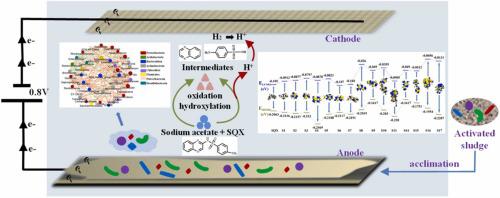当前位置:
X-MOL 学术
›
J. Environ. Chem. Eng.
›
论文详情
Our official English website, www.x-mol.net, welcomes your
feedback! (Note: you will need to create a separate account there.)
Co-metabolism driven sulfaquinoxaline removal in microbial electrolysis cells: A mechanistic analysis based on DFT calculation, metabolic pathway and functional enzyme activity
Journal of Environmental Chemical Engineering ( IF 7.4 ) Pub Date : 2024-02-07 , DOI: 10.1016/j.jece.2024.112153 Yuxia Zhao , Jierong Zheng , Xiaowen Li , Sufang Wang , Aijuan Zhou , Houfen Li , Bowei Zhao , Xiuping Yue
Journal of Environmental Chemical Engineering ( IF 7.4 ) Pub Date : 2024-02-07 , DOI: 10.1016/j.jece.2024.112153 Yuxia Zhao , Jierong Zheng , Xiaowen Li , Sufang Wang , Aijuan Zhou , Houfen Li , Bowei Zhao , Xiuping Yue

|
Sulfaquinoxaline (SQX) is a vital sulfonamide antibiotic for the treatment of livestock infections. Although its degradation has become a research focus in the last few years, its biodegradation process and biometabolic mechanisms were rarely studied. In this research, microbial electrolytic cells (MECs) were used to remove SQX using sodium acetate as a co-substrate. The findings indicated that the maximum removal rate of SQX for a 5-day period in co-substrate reached 94.2%, and SQX exhibited a lower resistance (45.64 Ω) and had a larger double-layer area than a single substrate (95.03 Ω). LCMS/MS analysis suggested that SQX could eventually degrade to 17 byproducts through hydrolysis, hydroxylation, N rearrangement and sulfur reduction. Density flooding theory (DFT) calculations showed that sodium acetate addition weakened the N-C bond and facilitated hydroxylation. Meanwhile, the fluorescence composition of fDOM shifted from protein-like to humic acid-like with co-substrate supplementation. Microbial community analysis showed that and were highly correlated with SQX removal. Analysis of the metabolic pathways showed that key enzymes such as NAT, CAT, DHP and NAD were involved in the degradation of SQX. Biotoxicity tests indicated that weak electrical stimulation was beneficial in reducing biotoxicity. These results provide theoretical basis and new insights into the bioelectrochemical degradation of SQX.
更新日期:2024-02-07































 京公网安备 11010802027423号
京公网安备 11010802027423号